Goodman ARUF31B14, ARUF37C14, ARUF47D14, ARUF61D14, ASPT33C14 Installation Manual
...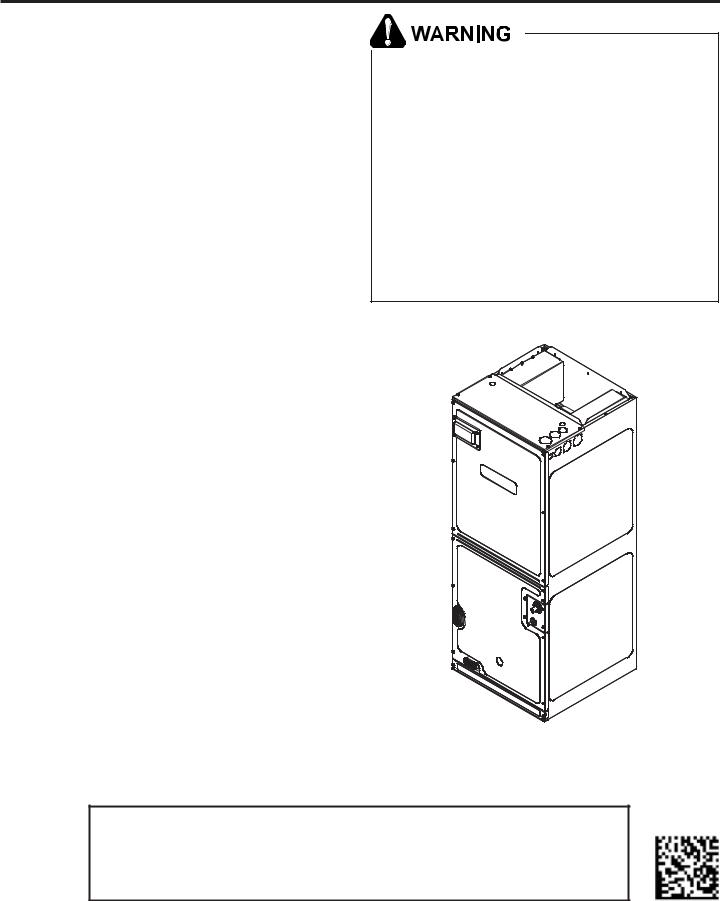
ARUF**14** / ASPT**14**
AIR HANDLERS INSTALLATION & OPERATING INSTRUCTIONS
Contents |
|
||
1 |
Important Safety Instructions ................................... |
1 |
|
2 |
Shipping Inspection ............................................... |
3 |
|
|
2.1 |
Parts ............................................................. |
3 |
|
2.2 Handling ........................................................ |
3 |
|
3 |
Codes & Regulations .............................................. |
3 |
|
4 |
Replacement Parts ................................................ |
3 |
|
5 |
Pre-Installation Considerations ................................ |
3 |
|
|
5.1 |
Preparation..................................................... |
3 |
|
5.2 |
System Matches ................................................ |
3 |
|
5.3 |
Interconnecting Tubing ....................................... |
3 |
|
5.4 |
Clearances ...................................................... |
3 |
|
5.5 |
Horizontal Applications ...................................... |
3 |
6 |
Installation Location ............................................. |
4 |
|
|
6.1 |
Upflow Installation ........................................... |
4 |
|
6.2 |
Horizontal Left Installation ................................. |
4 |
|
6.3 |
Horizontal Right Installation / Downflow Installation .. |
4 |
7 |
Refrigerant Lines .................................................. |
6 |
|
|
7.1 |
Tubing Size ..................................................... |
6 |
|
7.2 |
Tubing Preparation ............................................ |
6 |
|
7.3 |
Special Instructions ........................................... |
6 |
|
7.4 |
Tubing Connections for Flowrator Model .................. |
8 |
|
7.5 |
Tubing Connections for TXV Models ........................ |
8 |
|
7.6 ASPT**14** Models with Non-Adjustable TXV ............. |
8 |
|
|
7.7 |
Thermal Expansion Valve System Adjustment ............ |
9 |
8 |
Condensate Drain Lines ......................................... |
10 |
|
9 |
Ductwork ........................................................... |
11 |
|
|
9.1 |
Return Ductwork ............................................ |
11 |
10 |
Return Air Filters ............................................... |
11 |
|
11 |
Electric Heat ..................................................... |
11 |
|
12 Electrical and Control Wiring ................................ |
12 |
||
|
12.1 Building Electrical Service Inspection .................. |
12 |
|
|
12.2 Wire Sizing .................................................. |
12 |
|
|
12.3 Maximum Overcurrent Protection (MOP) .............. |
12 |
|
|
12.4 Electrical Connections – Supply Voltage ................ |
12 |
|
|
|
12.4.1 Air Handler Only (Non-Heat Kit Models) ...... |
14 |
|
|
12.4.2 Air Handler - Non-Circuit Breaker Heat Kits . 14 |
|
|
|
12.4.3 Air Handler With Circuit Breaker Heat Kit ... |
14 |
|
12.5 Low Voltage Connections ................................. |
14 |
|
|
|
12.5.1 Thermostats ....................................... |
14 |
|
12.6 Speed Tap Adjustment .................................... |
14 |
|
13 |
Achieving 1.4% Low Leakage Rate ......................... |
14 |
|
14 |
Start-Up Procedure ............................................. |
15 |
|
15 |
Regular Maintenance ........................................... |
15 |
|
16 |
Airflow Data ..................................................... |
16 |
|
17 Air Handler Low Voltage Connections ...................... |
18 |
||
18 |
Wiring Diagrams ................................................. |
19 |
|
Only personnel that have been trained to install, adjust, service or repair (hereinafter, “service”) the equipment specified in this manual should service the equipment. The manufacturer will not be responsible for any injury or property damage arising from improper service or service procedures. If you service this unit, you assume responsibility for any injury or property damage which may result. In addition, in jurisdictions that require one or more licenses to service the equipment specified in this manual, only licensed personnel should service the equipment. Improper installation, adjustment, servicing or repair of the equipment specified in this manual, or attempting to install, adjust, service or repair the equipment specified in this manual without proper training may result in product damage, property damage, personal injury or death.
 RECOGNIZE THIS SYMBOL
RECOGNIZE THIS SYMBOL
AS A SAFETY PRECAUTION.
Keep this literature in a safe place for future reference.
IO-901G 12/2017
ATTENTION INSTALLING PERSONNEL
Prior to installation, thoroughly familiarize yourself with this Installation Manual. Observe all safety warnings. During installation or repair, caution is to be observed.
It is your responsibility to install the product safely and to educate the customer on its safe use.
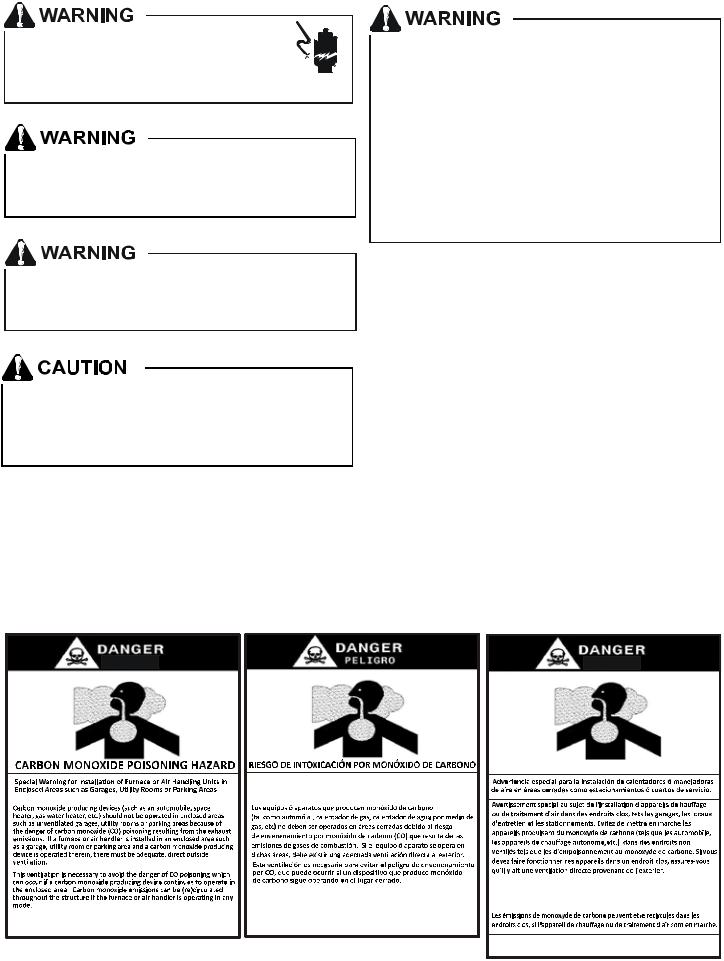
HIGH VOLTAGE!
Disconnect ALL power before servicing. 



 Multiple power sources may be present.
Multiple power sources may be present. 

 Failure to do so may cause property damage, personal injury or death.
Failure to do so may cause property damage, personal injury or death.
To prevent the risk of property damage, personal injury, or death, do not store combustible materials or use gasoline or other flammable liquids or vapors in the vicinity of this unit.
This product is factory-shipped for use with 208/240/1/60 electrical power supply. DO NOT reconfigure this air handler to operate with any other power supply.
To avoid property damage, personal injury or death due to electrical shock, this unit MUST have an uninterrupted, unbroken electrical ground. The electrical ground circuit may consist of an appropriately sized electrical wire connecting the ground lug in the unit control box to the building electrical service panel.
Other methods of grounding are permitted if performed in accordance with the National Electric Code (NEC)/American National Standards Institute (ANSI)/National Fire Protection Association (NFPA) 70 and local/state codes. In Canada, electrical grounding is to be in accordance with the Canadian Electric Code (CSA) C22.1.
When installing or servicing this equipment, safety clothing, including hand and eye protection, is strongly recommended. If installing in an area that has special safety requirements (hard hats, etc.), observe these requirements.
1 Important Safety Instructions
The following symbols and labels are used throughout this manual to indicate immediate or potential safety hazards. It is the owner’s and installer’s responsibility to read and comply with all safety information and instructions accompanying these symbols. Failure to heed safety information increases the risk of personal injury, property damage, and/ or product damage.
RISQUE D'EMPOISONNEMENT AU MONOXYDE DE CARBONE
Advertencia especial para la instalación de calentadores ó manejadoras de aire en áreas cerradas como estacionamientos ó cuartos de servicio.
|
|
|
|
|
|
|
|
|
|
|
|
|
|
|
|
|
|
|
|
|
|
|
|
|
|
|
|
|
|
|
|
|
|
|
|
|
|
|
|
|
|
|
|
|
|
|
|
|
|
|
|
|
|
|
|
|
|
|
|
|
|
|
|
|
|
|
|
|
|
|
|
|
|
|
|
|
|
|
|
|
|
|
|
|
|
|
|
|
|
|
|
|
|
|
|
|
|
|
|
|
|
|
|
|
|
|
|
|
|
|
|
|
|
|
|
|
|
|
|
|
|
|
|
|
|
|
|
|
|
|
|
|
|
|
Las emisiones de monóxido de carbono pueden circular a través |
||||||||
|
|
|
|
|
|
|
|
|
|||||||||
|
|
|
|
|
|
|
|
|
|||||||||
|
|
|
|
|
|
|
|
|
|||||||||
|
|
|
|
|
|
|
|
|
|||||||||
|
|
|
|
|
|
|
|
|
del aparato cuando se opera en cualquier modo. |
|
|
|
|||||
|
|
|
|
|
|
|
|
|
|
|
|
|
|
|
|
|
|
|
|
|
|
|
|
|
|
|
|
|
|
|
|
|
|
|
|
|
CO can cause serious illness including permanent brain |
|
|
|
|
|
|
|
El monóxido de carbono puede causar enfermedades severas |
||||||||
|
damage or death. |
B10259-216 |
como daño cerebral permanente ó muerte. |
B10259-216 |
|||||||||||||
Cette ventilation est nécessaire pour éviter le danger d'intoxication au CO pouvant survenir si un appareil produisant du monoxyde
de carbone continue de fonctionner au sein de la zone confinée.
Le monoxyde de carbone peut causer des maladies graves telles que des dommages permanents au cerveau et meme la mort. B10259-216
2
2 Shipping Inspection
Always transport the unit upright; laying the unit on its side or top during transit may cause equipment damage. The installer should inspect the product upon receipt for shipping damage and subsequent investigation is the responsibility of the carrier. The installer must verify the model number, specifications, electrical characteristics, and accessories are correct prior to installation. The distributor or manufacturer will not accept claims from dealers for transportation damage or installation of incorrectly shipped units.
2.1Parts
Also inspect the unit to verify all required components are present and intact. Report any missing components immediately to the manufacturer or to the distributor. Use only factory authorized replacement parts (see Section 5). Make sure to include the full product model number and serial number when reporting and/or obtaining service parts.
2.2Handling
Use caution when transporting/carrying the unit. Do not move unit using shipping straps. Do not carry unit with hooks or sharp objects. The preferred method of carrying the unit after arrival at the job site is to carry via a two-wheel hand truck from the back or sides or via hand by carrying at the cabinet corners.
3 Codes & Regulations
This product is designed and manufactured to comply with applicable national codes. Installation in accordance with such codes and/or prevailing local codes/regulations is the responsibility of the installer. The manufacturer assumes no responsibility for equipment installed in violation of any codes or regulations.
The United States Environmental Protection Agency (EPA) has issued various regulations regarding the introduction and disposal of refrigerants. Failure to follow these regulations may harm the environment and can lead to the imposition of substantial fines. Should you have any questions please contact the local office of the EPA and/or refer to EPA’s website www.epa.gov.
4 Replacement Parts
When reporting shortages or damages, or ordering repair parts, give the complete product model and serial numbers as stamped on the product. Replacement parts for this product are available through your contractor or local distributor. For the location of your nearest distributor consult the white business pages, the yellow page section of the local telephone book or contact:
HOMEOWNER SUPPORT
GOODMAN MANUFACTURING COMPANY, L.P.
19001 KERMIER ROAD
WALLER, TEXAS 77484 (877) 254-4729
5 Pre-Installation Considerations
5.1Preparation
Keep this document with the unit. Carefully read all instructions for the installation prior to installing product. Make sure each step or procedure is understood and any special considerations are taken into account before starting installation. Assemble all tools, hardware and supplies needed to complete the installation. Some items may need to be purchased locally. Make sure everything needed to install the product is on hand before starting.
5.2System Matches
The entire system (combination of indoor and outdoor sections) must be manufacturer approved and Air-Con- ditioning, Heating, and Refrigeration Institute (AHRI) listed. NOTE: Installation of unmatched systems is not permitted.
5.3Interconnecting Tubing
Give special consideration to minimize the length of refrigerant tubing when installing air handlers. Refer to Remote Cooling/Heat Pump Service Manual RS6200006, and TP-107 Long Line Set Application R- 410A for tubing guidelines. If possible, allow adequate length of tubing such that the coil may be removed (for inspection or cleaning services) from the cabinet without disconnecting the tubing.
5.4Clearances
The unit clearance from a combustible surface may be 0". However, service clearance must take precedence. A minimum of 24" in front of the unit for service clearance is required. Additional clearance on one side or top will be required for electrical wiring connections. Consult all appropriate regulatory codes prior to determining final clearances. When installing this unit in an area that may become wet (such as crawl spaces), elevate the unit with a sturdy, non-porous material. In installations that may lead to physical damage (i.e. a garage) it is advised to install a protective barrier to prevent such damage. Always install units such that a positive slope in condensate line (1/4" per foot) is allowed.
5.5Horizontal Applications
If installed above a finished living space, a secondary drain pan (as required by many building codes), must be installed under the entire unit and its condensate drain line must be routed to a location such that the user will see the condensate discharge.
3
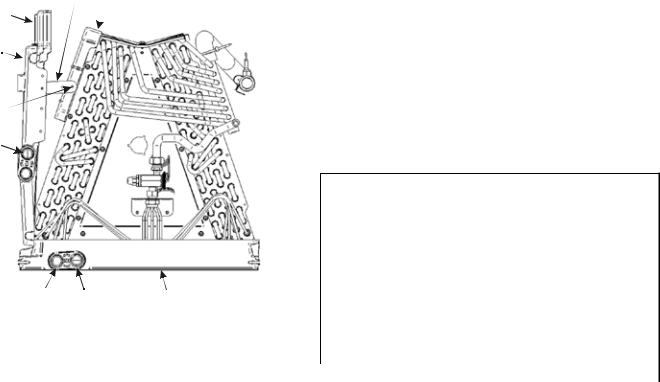
6 Installation Location
NOTE: These air handlers are designed for indoor installation only.
The ARUF**14** and ASPT**14** product lines may be installed in one of the upflow, downflow, horizontal left or horizontal right orientations as shown in Figures 2, 3, 4 and 5. The unit may be installed in upflow or horizontal left orientation as shipped (refer to specific sections for more information).
No field modifications are mandatory. However, to obtain maximum efficiency, the horizontal drip shield, side drain pan and drain pan extension can be removed.
Side Drain Pan and Extension Removal: Refer to Figure 1, remove the two (2) screws that secure the drip shield support brackets to the condensate collectors (front and back). Unsnap the side drain pan from the bottom drain pan using a screw driver or any small lever. The side drain pan, drip shield brackets and the drain pan extension may now be removed. From Figure 1, drain port labeled (A) is the primary drain for this application and condensate drain line must be attached to this drain port. Drain port (a) is for the secondary drain line (if used).
Drip Shield Bracket
Drip Pan Drip Shield
Extension
Side
Drain
Pan
Screw
b
B
A |
a |
Main Drain Pan |
SIDE DRAIN PAN REMOVAL
Figure 1
6.1 Upflow Installation
No field modifications are mandatory.
6.2 Horizontal Left Installation
No field modifications are permissible for this application. Install unit as shown in Figure 4.
Remove red plugs from side drain pan before connecting condensate drain pipes. Use removed plug to close drain ports on vertical drain pan. The bottom right drain connection in side drain pan is the primary drain for this application and condensate drain line must be attached to this drain connection. The bottom left drain connection in side drain pan is for the secondary drain line (if used).
In applications where the air handler is installed in the horizontal left position, and the return air environment see humidity levels above 65% relative humidity coupled with total external static levels above 0.5” e.s.p., a condensate kit is available for field application. Kit nomenclature can be found in Table 1.
CMK0008 |
CMK0009 |
CMK0010 |
CMK0011 |
CMK0012 |
CMK0013 |
CMK0014 |
Condensate |
Condensate |
Condensate |
Condensate |
Condensate |
Condensate |
Condensate |
Kit |
Kit |
Kit |
Kit |
Kit |
Kit |
Kit |
ARUF25B14 |
ARUF31B14 |
ARUF37C14 |
ARUF47D14 |
ARUF61D14 |
ASPT33C14 |
ASPT49C14 |
ARUF29B14 |
ASPT29B14 |
ARUF37D14 |
|
ASPT49D14 |
ASPT39C14 |
|
ASPT25B14 |
ASPT37B14 |
ARUF43C14 |
|
ASPT61D14 |
|
|
|
|
ARUF43D14 |
|
|
|
|
|
|
ARUF49C14 |
|
|
|
|
|
|
ARUF49D14 |
|
|
|
|
|
|
ASPT37C14 |
|
|
|
|
|
|
ASPT47C14 |
|
|
|
|
|
|
ASPT47D14 |
|
|
|
|
|
|
ASPT59C14 |
|
|
|
|
CONDENSATE KIT
Table 1
6.3 Horizontal Right Installation / Downflow Installation
When installing unit in the downflow position the appropriate (DFK) downflow kit is required to prevent “coil pan sweating”. The DFK kit is not supplied with the air handler and is available through your local distributor. See Table 2 for the correct DFK and follow the instructions provided for installation.
Side drain pan extension must be removed in the downflow and horizontal right applications for all models except: ARUF47D14**, ARUF61D14**, ASPT61D14**, ASPT49D14**.
Refer to Figure 6 and 7 for the location of the components referenced in the following steps.
MODEL LIST FOR DOWNFLOW KIT
DFK-B |
DFK-C |
DFK-D |
DOWNFLOW KIT |
DOWNFLOW KIT |
DOWNFLOW KIT |
ARUF25B14** |
ARUF37C14** |
ARUF37D14** |
ARUF29B14** |
ARUF43C14** |
ARUF43D14** |
ARUF31B14** |
ARUF49C14** |
ARUF47D14** |
ASPT25B14** |
ASPT33C14** |
ARUF49D14** |
ASPT29B14** |
ASPT37C14** |
ARUF61D14** |
ASPT35B14** |
ASPT39C14** |
ASPT61D14** |
ASPT37B14** |
ASPT47C14** |
ASPT47D14** |
|
ASPT49C14** |
ASPT49D14** |
|
ASPT59C14** |
|
DOWNFLOW KIT
Table 2
1.Before inverting the air handler, remove blower access panel and coil access panel. The coil access panel and tubing panel may remain screwed together during this procedure. Remove and retain the seven (7) screws securing the coil access panel to the cabinet and the six (6) screws securing the blower access panel to the cabinet.
4

2.Slide the coil assembly out from the cabinet. Use the drain pan to pull the assembly from the cabinet.
NOTE: DO NOT USE MANIFOLDS OR FLOWRATOR TO PULL THE COIL ASSEMBLY OUT. FAILURE TO DO SO MAY RESULT IN BRAZE JOINT DAMAGE AND LEAKS.
3.Removal of the center support is required on units with 21" wide cabinet. Remove and retain the two (2) screws that secure the center support to the cabinet. Remove the center support.
4.Position the unit in the downflow position.
5.Using the drain pan to hold the coil assembly, slide the coil assembly back into the cabinet on the downflow brackets as shown in Figure 8.
6.Reinstall the center support (if removed) using the two
(2) screws removed in Step 5.
7.Reinstall the coil access panels and reinstall blower access panel removed in Step 1 as shown in Figure 9.
8.Drain Connections for Horizontal Right Installation
a.The bottom right drain connection in side drain pan is the primary drain for this application and condensate drain line must be attached to this drain connection. The bottom left drain connection is for the secondary drain line (if used).
b.Remove red plugs from side drain pan before connecting condensate drain pipes. Use removed plug to close drain ports on vertical drain pan.
9.Drain Connections for Downflow Installation
a.The bottom left drain connection in the vertical drain pan is the primary drain for this application and condensate drain line must be attached to this drain connection. The bottom right drain connection is for the secondary drain line (if used).
b.Remove red plugs from vertical drain pan before connecting condensate drain pipes.
NOTE: If removing only the coil access panel from the unit, the filter access panel must be removed first. Failure
to do so will result in panel damage.
UPFLOW |
Figure 2 |
DOWNFLOW |
Figure 3 |
5
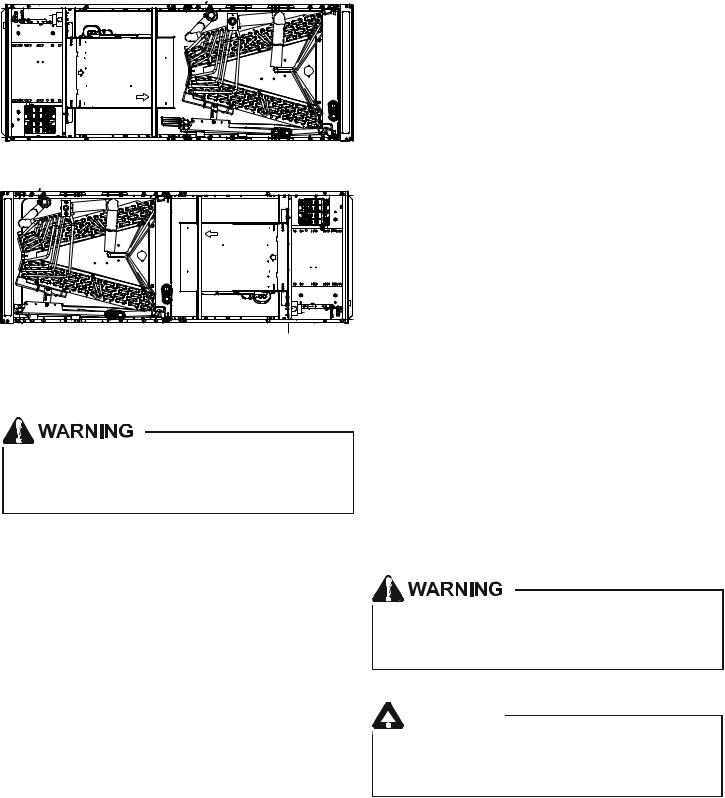
HORIZONTAL LEFT
Figure 4
HORIZONTAL RIGHT
Figure 5
7 Refrigerant Lines
This product is factory-shipped with R410A and dry nitrogen mixture gas under pressure. Use appropriate service tools and follow these instructions to prevent injury.
NOTE: Refrigerant tubing must be routed to allow adequate access for servicing and maintenance of the unit.
Do not install the air handler in a location that violates the instructions provided with the condenser. If the unit is located in an unconditioned area with high ambient temperature and/or high humidity, the air handler may be subject to nuisance sweating of the air handler cabinet. On these installations, a wrap of 2" fiberglass insulation with a vapor barrier is recommended.
7.1Tubing Size
For the correct tubing size, follow the specification for the condenser/heat pump.
7.2Tubing Preparation
All cut ends are to be round, burr free, and clean. Failure to follow this practice increases the chances for refrigerant leaks. The suction line is spun closed and requires tubing cutters to remove the closed end.
NOTE: To prevent possible damage to the tubing joints, do not handle coil assembly with manifold or flowrator tubes. Always use clean gloves when handling coil assemblies.
7.3Special Instructions
Units without a factory installed TXV come equipped with a flowrator piston for refrigerant expansion. For most installations with matching applications, no change to the flowrator piston is required. However, in mix-matched applications, a flowrator piston change may be required. See the piston kit chart (provided in the literature packet) or consult your local distributor for details regarding mix-matched flowrator piston sizing. If the mix-match application requires a different flowrator piston size, change the flowrator piston in the flowrator body on the indoor coil before installing the coil and use the procedure in section 7.4.
NOTE: The use of a heat shield is strongly recommended when brazing to avoid burning the serial plate or the finish of the unit. Heat trap or wet rags must be used to protect heat sensitive components such as service valves and TXV valves sensing bulb.
A quenching cloth is strongly recommended to prevent scorching or marring of the equipment finish when brazing close to the painted surfaces. Use brazing alloy of 5% minimum silver content.
 CAUTION
CAUTION
Applying too much heat to any tube can melt the tube. Torch heat required to braze tubes of various sizes must be proportional to the size of the tube. Service personnel must use the appropriate heat level for the size of the tube being brazed.
6
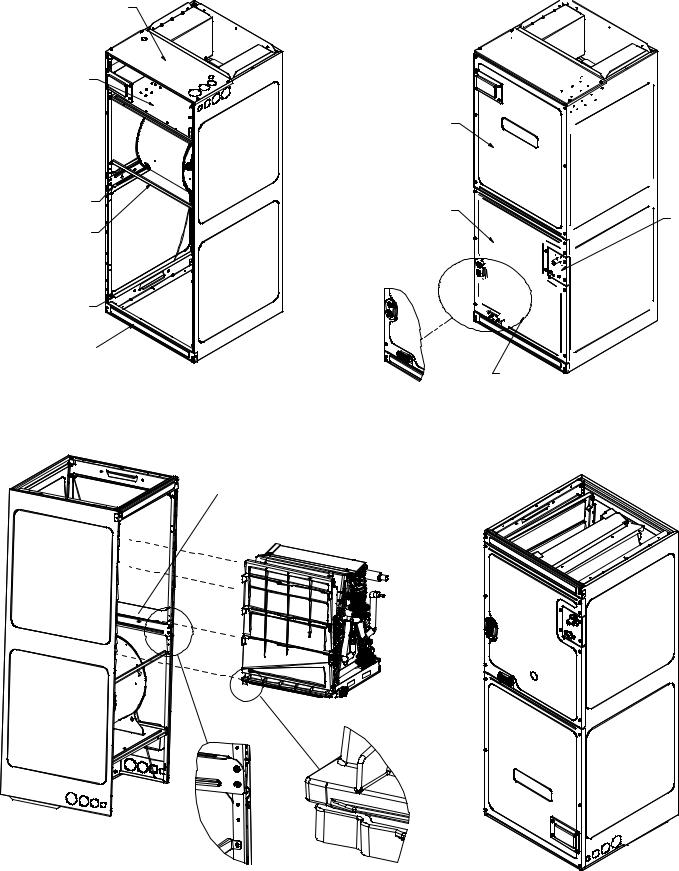
Upper Tie Plate |
|
|
Control |
|
|
Deck |
|
|
|
Blower |
|
|
Access |
|
|
Panel |
|
Downflow |
Coil |
|
Bracket |
||
Access |
||
|
||
Center |
Panel |
|
Support |
|
|
Filter |
|
|
Bracket |
|
|
Filter |
|
|
Access |
UV |
|
Panel |
||
|
Knockout |
INTERNAL PART TERMINOLOGY |
|
Figure 6 |
EXTERNAL PART TERMINOLOGY |
|
|
|
Figure 7 |
Coil slides
on the downflow bracket
Tubing
Panel
IMPORTANT NOTE:
Ensure coil slides on the rails along the groove provided on the drain pan side walls. Failure to do so will result in improper condensate drainage.
COIL INSTALLATION FOR DOWNFLOW
Figure 8
ACCESS PANEL CONFIGURATION FOR DOWNFLOW
OR HORIZONTAL RIGHT
Figure 9
7
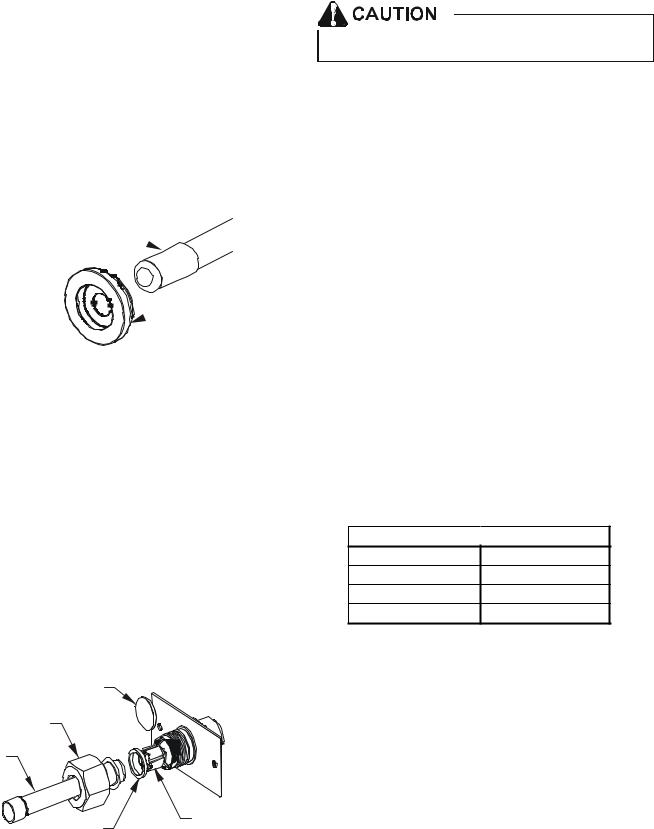
7.4Tubing Connections for Flowrator Model
1.Loosen the 13/16 nut 1 TURN ONLY to allow high pressure tracer gas to escape. No gas indicates a possible leak.
2.After the gas has been expelled, remove the nut and discard the black or brass cap plastic seal.
3.Remove the flowrator piston to verify it is the correct size for the outdoor unit being installed and then replace the piston (changing size, if needed). See piston kit chart in the literature kit for appropriate piston size.
4.Remove the spin closure on the suction line using a tube cutter and deburr the tube.
SUCTION LINE
WITH SPIN CLOSURE 
RUBBER
 GROMMET
GROMMET
SUCTION SPUN END AND GROMMET
Figure 10
5.Insert the suction line into the connection, slide the insulation and the rubber grommet at least 18" away from the braze joint.
6.Remove the tailpiece clamped to the exterior of the cabinet or in the literature kit packet and slide the
13/16 nut into place.
7.Braze tailpiece to the line set liquid tube and braze suction line connection. Quench all brazed joints with a damp rag upon completion of brazing. Do not allow water to enter the inside of the tubing.
8.AFTER THE TAILPIECE HAS COOLED, confirm position of the white Teflon® seal and hand tighten the 13/16 nut.
PLASTIC or BRASS CAP
13/16” NUT
TAILPIECE
WHITE |
PISTON |
|
|
TEFLON SEAL |
|
TAILPIECE JOINT
Figure 11
9.Torque the 13/16 nut to 7-25 ft-lbs. or tighten 1/6 turn.
Excessive torque can cause orifices to stick. Use the proper torque settings when tightening orifices.
7.5Tubing Connections for TXV Models
TXV models come with factory installed TXV with the bulb pre-installed on the vapor tube.
1.Remove refrigerant tubing panel or coil (lower) access panel.
2.Remove access valve fitting cap and depress the valve stem in access fitting to release pressure. No pressure indicates possible leak.
3.Replace the refrigerant tubing panel.
4.Remove the spin closure on both the liquid and suction tubes using a tubing cutter.
5.Insert liquid line set into liquid tube expansion and slide grommet about 18" away from braze joint.
6.Insert suction line set into suction tube expansion and slide insulation and grommet about 18" away from braze joint.
7.Braze joints. Quench all brazed joints with water or a wet rag upon completion of brazing.
7.6ASPT**14** Models with Non-Adjustable TXV
ASPT air handlers equipped with Parker non-adjustable TXV should be charged by subcooling only.
Models
ASPT25B14** ASPT47D14**
ASPT29B14** ASPT47C14**
ASPT37B14** ASPT49D14**
ASPT37C14** ASPT59C14**
Table 3
See section 7.7 for detailed information on adjusting the thermal expansion valve.
8

7.7 Thermal Expansion Valve System Adjustment
Run the system at Cooling for 10 minutes until refrigerant pressures stabilize. Use the following guidelines and methods to check unit operation and ensure that the refrigerant charge is within limits. Charge the unit on low stage.
1.Purge gauge lines. Connect service gauge manifold to base-valve service ports.
2.Temporarily install a thermometer on the liquid line at the liquid line service valve and 4-6" from the compressor on the suction line. Ensure the thermometer makes adequate contact and is insulated for best possible readings. Use liquid line temperature to determine subcooling and vapor temperature to determine superheat.
3.Check subcooling and superheat. Systems with TXV application should have a subcooling of 7 to 9ºF and superheat of 7 to 9 ºF.
a. If subcooling and superheat are low, adjust TXV to 7 to 9 ºF superheat, then check subcooling.
NOTE: To adjust superheat, turn the valve stem clockwise to increase and counter clockwise to decrease.
b.If subcooling is low and superheat is high, add charge to raise subcooling to 7 to 9ºF then check superheat.
c.If subcooling and superheat are high, adjust TXV valve to 7 to 9 ºF superheat, then check subcooling.
d.If subcooling is high and superheat is low, adjust TXV valve to 7 to 9 ºF superheat and remove charge to lower the subcooling to 7 to 9ºF.
NOTE: Do NOT adjust the charge based on suction pressure unless there is a gross undercharge.
4. Disconnect manifold set, installation is complete.
NOTE: Check the Schrader ports for leaks and tighten valve cores if necessary. Install caps finger-tight.
SUBCOOL FORMULA =
SAT. LIQUID LINE TEMP. - LIQUID LINE TEMP. SUPERHEAT FORMULA =
SUCT. LINE TEMP. - SAT. SUCT. TEMP.
NOTE: Expansion valve system in ASPT models are already tuned for 16 SEER single stage Heat Pump, adjustment of Expansion valve system is required in case subcool, superheat does not match to Section 7.6.3 above or when these models are installed with any other outdoor models.
SATURATED SUCTION PRESSURE
TEMPERATURE CHART
SUCTION PRESSURE |
SATURATED SUCTION |
|
PSIG |
R-22 |
R-410A |
|
|
|
50 |
26 |
1 |
52 |
28 |
3 |
54 |
29 |
4 |
56 |
31 |
6 |
58 |
32 |
7 |
60 |
34 |
8 |
62 |
35 |
10 |
64 |
37 |
11 |
66 |
38 |
13 |
68 |
40 |
14 |
70 |
41 |
15 |
72 |
42 |
16 |
74 |
44 |
17 |
76 |
45 |
19 |
78 |
46 |
20 |
80 |
48 |
21 |
85 |
50 |
24 |
90 |
53 |
26 |
95 |
56 |
29 |
100 |
59 |
31 |
110 |
64 |
36 |
120 |
69 |
41 |
130 |
73 |
45 |
140 |
78 |
49 |
150 |
83 |
53 |
160 |
86 |
56 |
170 |
90 |
60 |
9
